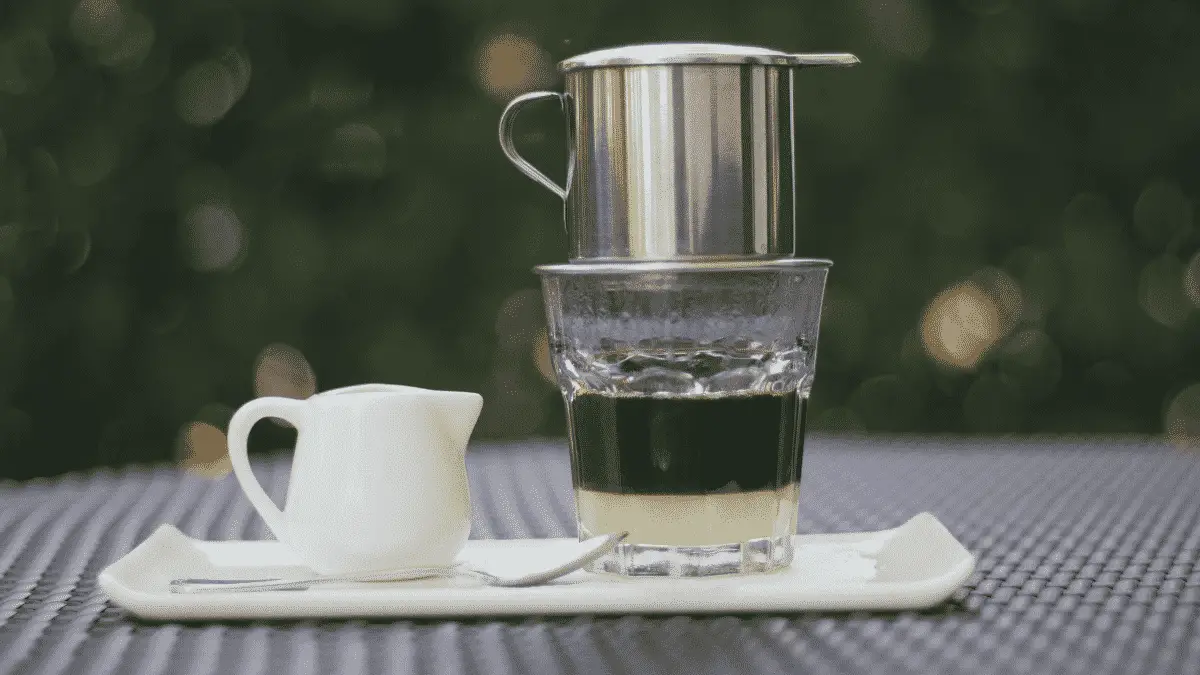Introduced to Vietnam by French colonists in the 19th Century, coffee and coffee culture quickly took off in this country and has grown exponentially ever since. While Vietnamese coffee may be most popularly associated with strong drip coffee that is made with condensed milk, there is much more to the Vietnamese coffee culture than this one beverage.
The coffee culture in Vietnam is a strong one, boasting a long and unique history. Beyond the rich, creamy, condensed milk coffee that typically comes to mind when you hear the words ‘Vietnam’ and ‘coffee’, Vietnam is also one of the largest producers of coffee in the world.
To understand the rich tapestry of coffee culture in Vietnam, I’ve put together a guide to this unique and distinctive aspect of Vietnamese life. I’ll take you through what makes Vietnamese coffee different, how you can make your own Vietnamese coffee, the different types and styles of Vietnamese coffee, and just why Vietnamese coffee is so strong!
Is Vietnam famous for coffee?
While it may not be the first thing that springs to mind when thinking of coffee in Vietnam, the country’s greatest claim to fame when it comes to coffee is their position as the world’s second largest producer.
Vietnamese production accounts for a whopping 20% of the world’s supply of coffee, coming second only to the coffee production powerhouse that is Brazil. So what types of coffee beans does Vietnam produce?
The vast majority of coffee beans grown in Vietnam are Robusta beans, accounting for a massive 97% of the country’s total coffee output. The remaining 3% of coffee beans are Arabica beans.
The choice to grow Robusta beans comes from their particular suitability to the Vietnamese climate, the soil conditions in the main growing regions, and their ability to produce a high yield of beans.
Besides its prominent position as a leading worldwide producer of coffee beans, Vietnam is also famous for the unique and distinctive way in which coffee is prepared and drunk in this country.
There are many ways to enjoy coffee in the traditional Vietnamese style. There is – of course – the ubiquitous Vietnamese coffee with condensed milk, but what about Vietnamese coffee with egg? Or Vietnamese coffee with yogurt?
Whatever way it is prepared, one of the things that all types of traditional Vietnamese coffee have in common is the rich, strong flavor of roasted Vietnamese coffee beans – but more on that later!
What is different about Vietnamese coffee?
Given that coffee was introduced to Vietnam by the French in the 19th Century, it is perhaps not surprising that many types of Vietnamese coffee have an air of experimentation to them.
As the French were unable to access all their usual accompaniments for le café, such as fresh milk and cream, they often had to improvise. This is actually how the famous Vietnamese coffee with condensed milk was born! Coffee drinkers soon found that this sweet, syrupy milk with a long shelf life made for a great addition to coffee, and the rest is history!
Besides its unique ingredients and additions, one of the biggest differences between your everyday coffee and Vietnamese coffee comes through the roasting process.
As anyone who has had the pleasure of drinking Vietnamese coffee will attest, it is an extremely strong, extremely flavorful beverage. This is because Vietnamese coffee roasters roast their beans with a whole host of unique ingredients.
Some of these unique ingredients include rice wine, salt, and even butter! It is the latter ingredient that can account for some of the richness and unctuousness in Vietnamese coffee. Depending on the roastery, which often roasts specifically for the tastes of their local clientele, some Vietnamese coffee roasteries may even add chocolate or caramel to their beans!
Adding to the already rich flavor that Vietnamese coffee beans boast on their own, is the Vietnamese coffee brewing process. Most traditionally brewed with a filter device called a Vietnamese coffee phin, which is placed over the coffee drinker’s cup and filled with coffee grinds before hot water is poured over and allowed to drip through.
The slow, drip brew process heightens the flavors of the beans, and delivers a strong, concentrated dose of coffee direct to the cup.
Given that Vietnamese coffee boasts such a strong, robust flavor profile, the choice to add other rich flavors to this coffee begins to make sense. As well as Vietnamese condensed milk coffee, other ways of taking and making Vietnamses coffee have emerged over the years.
Another popular coffee beverage in Vietnam is coffee made with rich, thick yogurt. Although this may not sound like a winning combination at first, the pairing of these two ingredients works extremely well.
Rather than topping the creamy yogurt with fruits, it is instead topped with a drizzle of rich, flavorful coffee. The coffee is then mixed into the yogurt, and slowly sipped. Like other types of Vietnamese coffee, this is an extremely refreshing beverage, best enjoyed on a hot, steamy day!
Vietnamese egg coffee is another popular way to enjoy coffee. Made with egg yolks whipped with condensed milk and added to coffee, Vietnamese egg coffee makes for a delicious dessert and has tiramisu-like flavor profiles. It could certainly be enjoyed with a touch of chocolate on top, or with a side of sponge cake!
What kind of coffee is used in Vietnamese coffee?
As Robusta coffee is the most commonly grown coffee in Vietnam, most traditional Vietnamese coffees are made with Robusta beans.
There are several popular Vietnamese coffee brands, including Trung Nguyen, which is always a hit with tourists returning from Vietnam who want to bring that distinctive Vietnamese coffee taste home with them! In fact, many Vietnamese coffee recipes call for use of Trung Nguyen brand coffee specifically.
If you wish to make Vietnamese coffee at home, using your own beans, you will need to ensure that you are using beans with a fairly coarse grind. This will allow the Vietnamese coffee phin filter to work its magic, letting the coffee brew correctly.
Is Vietnamese coffee unhealthy?
While ingredients such as egg yolk and condensed milk may not seem to be the world’s healthiest ingredients, traditionally made Vietnamese coffee is not particularly unhealthy.
Unlike the coffee consumption patterns in many Western countries, the coffee drinking experience in Vietnam places much greater emphasis on a slow, quiet enjoyment of your coffee. As opposed to gulping down several large coffees every day, traditional Vietnamese coffee is intended to be savoured and is consumed in much smaller quantities.
The portion size of a Vietnamese coffee is about the size of a regular tea cup. Additionally, the main ingredients are coffee beans and water, with only the smallest amount of condensed milk usually added.
With a tablespoon of condensed milk clocking in at about 45 calories, consuming a single Vietnamese coffee per day is still much less calorie dense than your average supersize latte.
How do you make Vietnamese coffee?
The recipe for Vietnamese coffee is fairly simple, but will require use of a Vietnamese coffee phin. If you want to brew your coffee grounds in a heatproof glass, then pour it through a paper filter into your coffee cup, it is possible, but you will lose the richness of the drip effect achieved by a phin.
To make Vietnamese coffee, use the following recipe:
- Remove the top screen of the phin filter and add coffee grounds. Replace the top screen and place the filter over your heat proof glass.
- Add a dash of boiling water into the filter to allow the coffee grounds to bloom. Watch for the beginnings of the drip into your glass.
- Once the coffee has started dripping through, pour enough water into the filter to fill it and replace the lid.
- Allow the coffee to drip through for five minutes.
- Add 1-2 tablespoons of condensed milk and stir through.
If you wish to make an iced Vietnamese coffee, follow the same process as listed above. Then, once you have stirred through the condensed milk, pour the coffee mixture over a glass filled with ice and enjoy!
Frequently Asked Questions
Does Starbucks have Vietnamese coffee?
Starbucks does not offer an authentic Vietnamese coffee, iced or otherwise. However, there are ways to hack the Starbucks menu that can deliver something very close to the distinctive taste os Vietnamese coffee.
By ordering several shots of espresso and topping them up a few pumps of white chocolate syrup, you can get the same strong taste and sweet, syrupy texture that Vietnamese coffee is so well known for!
What is the best commercial Vietnamese coffee brand?
If you are looking for a good commercial Vietnamese coffee brand to start your Vietnamese coffee brewing journey, you need look no further than Trung Nguyen. As one of the most famous Vietnamese coffee brands, this is most likely the type of coffee that you have seen in your local Vietnamese restaurant or cafe or in the local Asian supermarket.

